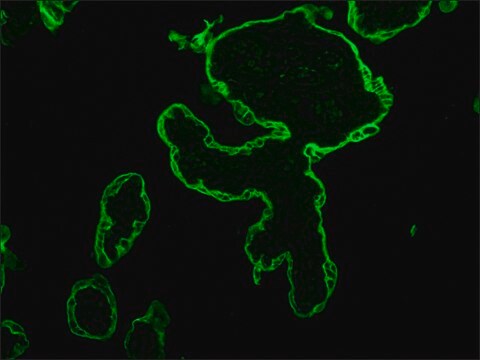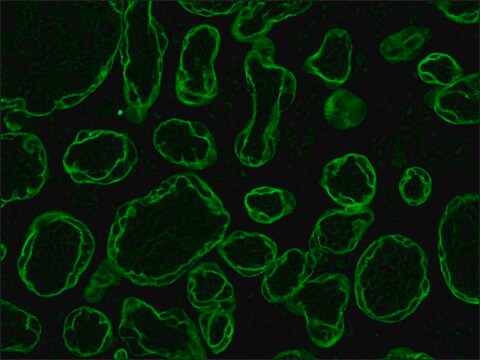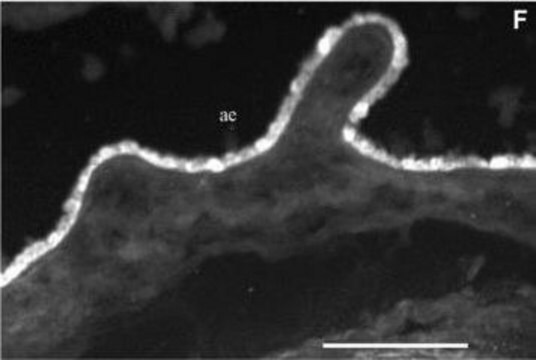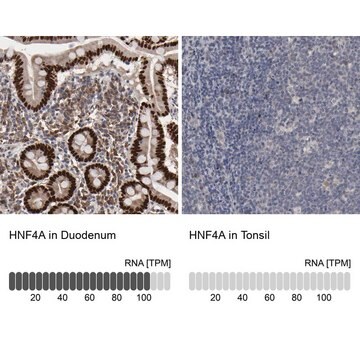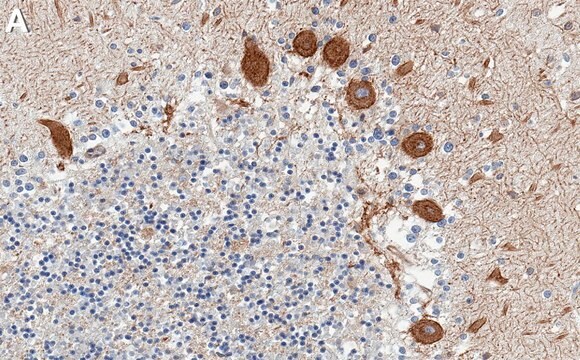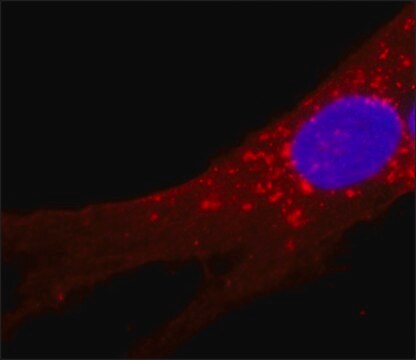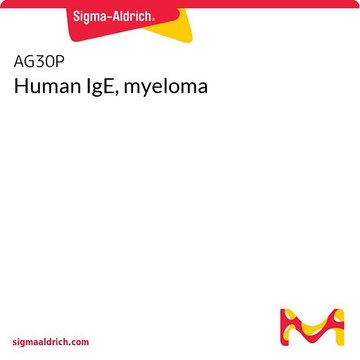추천 제품
생물학적 소스
mouse
결합
unconjugated
항체 형태
tissue culture supernatant
항체 생산 유형
primary antibodies
클론
A53-B/A2, monoclonal
분자량
antigen 40 kDa
포함
15 mM sodium azide
종 반응성
human
기술
indirect immunofluorescence: 1:50 using formalin-fixed, paraffin-embedded, human tissue sections
microarray: suitable
동형
IgG2a
UniProt 수납 번호
배송 상태
dry ice
저장 온도
−20°C
타겟 번역 후 변형
unmodified
유전자 정보
human ... KRT19(3880)
일반 설명
Monoclonal Anti-Cytokeratin Peptide 19 (mouse IgG2a isotype) is derived from the A53-B/A2 hybridoma produced by the fusion of mouse myeloma cells and splenocytes from BALB/c mice immunized with mammary human carcinoma cell line MCF-7. Monoclonal Anti-Cytokeratin Peptide 19, known as clone A53-B/A2, or clone No. Ks 19.1, reacts with the rod domain of human cytokeratin peptide 19 (40 kDa), a cytoskeletal protein restricted to epithelial and carcinoma cells. Cytokeratin 19 is a member of the type I acidic subfamily. It is differentially expressed in various human tissues.
특이성
Also cited as clone no. KS 19.1, the antibody reacts with the rod domain of cytokeratin peptide 19, a cytoskeletal protein restricted to epithelial and carcinoma cells. Species cross-reactivity is low or absent. The antibody labels simple epithelia and basal cells of non-cornifying stratified squamous epithelia. It is a useful tool in discriminating simple carcinomas from those of different origin and for carcinoma subtyping. This antibody has also been shown to be a marker of pre-malignant lesions of the oral epithelium.
면역원
human mammary carcinoma cell line MCF-7.
애플리케이션
Monoclonal Anti-Cytokeratin Peptide 19 antibody produced in mouse is also suitable:
- for immunoblotting, for immunocytochemistry,
- for immunofluorescence,
- as a marker of premalignant lesions of the oral epithelium, to label cytokeratin in formalin-fixed or Carnoy-fixed, paraffin embedded tissue and in frozen sections of human tissue, to label simple epithelia and basal cells of noncornifying stratified squamous epithelia.
Monoclonal Anti-Cytokeratin Peptide 19 antibody produced in mouse is suitable for microarray and indirect immunofluorescence at a dilution of 1:50 using formalin-fixed, paraffin-embedded and human tissue sections.
생화학적/생리학적 작용
Keratin, type I cytoskeletal 19 (40kDa protein) is also known as cytokeratin-19 (CK-19) or keratin-19 (K19). It is encoded by the KRT19 gene in humans. Keratin 19 is a type I keratin. Keratins are intermediate filament-forming proteins that provide mechanical support and perform a variety of additional functions in epithelial cells. K19 is expressed in a subset of hepatocellular carcinomas (HCC) with poor prognosis and is considered as a biliary/hepatic progenitor cell (HPC) marker. It is also a predictor of poorer prognosis for patients with human lung squamous cell carcinoma (SCC).
Monoclonal anti-cytokeratins are specific markers of epithelial cell differentiation and have been widely used as tools in tumor identification and classification.
면책조항
Unless otherwise stated in our catalog or other company documentation accompanying the product(s), our products are intended for research use only and are not to be used for any other purpose, which includes but is not limited to, unauthorized commercial uses, in vitro diagnostic uses, ex vivo or in vivo therapeutic uses or any type of consumption or application to humans or animals.
적합한 제품을 찾을 수 없으신가요?
당사의 제품 선택기 도구.을(를) 시도해 보세요.
Storage Class Code
10 - Combustible liquids
WGK
nwg
Flash Point (°F)
Not applicable
Flash Point (°C)
Not applicable
시험 성적서(COA)
제품의 로트/배치 번호를 입력하여 시험 성적서(COA)을 검색하십시오. 로트 및 배치 번호는 제품 라벨에 있는 ‘로트’ 또는 ‘배치’라는 용어 뒤에서 찾을 수 있습니다.
Kasper, M., et al.
European Journal of Cancer, 23, 137-137 (1987)
Izabela Podgorski et al.
The American journal of pathology, 175(3), 1255-1269 (2009-08-25)
Bone metastasis is a hallmark of advanced prostate and breast cancers, yet the critical factors behind attraction of tumors to the skeleton have not been validated. Here, we investigated the involvement of cathepsin K in the progression of prostate tumors
Minati Satpathy et al.
Theranostics, 9(3), 778-795 (2019-02-28)
Cancer heterogeneity and drug resistance limit the efficacy of cancer therapy. To address this issue, we have developed an integrated treatment protocol for effective treatment of heterogeneous ovarian cancer. Methods: An amphiphilic polymer coated magnetic iron oxide nanoparticle was conjugated
Targeted drug delivery and image-guided therapy of heterogeneous ovarian cancer using HER2-targeted theranostic nanoparticles
Satpathy M, et al.
Theranostics, 9(3), 778-778 (2019)
R Moll et al.
Laboratory investigation; a journal of technical methods and pathology, 65(1), 74-86 (1991-07-01)
The expression of intermediate filament proteins, particularly individual cytokeratins (CKs), vimentin, and glial filament protein, was immunohistochemically investigated using frozen sections and Carnoy-fixed, paraffin-embedded tissue from normal fetal and adult human kidneys as well as from pathologically altered kidneys. In
자사의 과학자팀은 생명 과학, 재료 과학, 화학 합성, 크로마토그래피, 분석 및 기타 많은 영역을 포함한 모든 과학 분야에 경험이 있습니다..
고객지원팀으로 연락바랍니다.